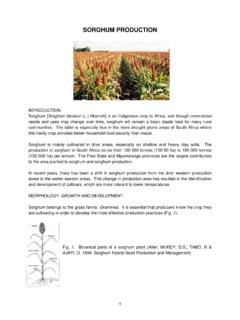Transcription of Classification by Distribution of Grain Sizes.
1 CE 340, Fall 2015 Soil Classification 1 / 7 The geotechnical engineer predicts the behavior of soils for his or her clients (structural engineers, architects, contractors, etc). A first step is to classify the soil. Soil is typically classified according to its Distribution of Grain sizes, its plasticity, and its relative density or stiffness. Classification by Distribution of Grain Sizes. While an experienced geotechnical engineer can visually examine a soil sample and estimate its Grain size Distribution , a more accurate determination can be made by performing a sieve analysis.
2 Sieve Analyis. In a sieve analysis, the dried soil sample is placed in the top of a stacked set of sieves. The sieve with the largest opening is placed on top, and sieves with successively smaller openings are placed below. The sieve number indicates the number of openings per linear inch ( a #4 sieve has 4 openings per linear inch). The results of a sieve analysis can be used to help classify a soil. Soils can be divided into two broad classes: coarse grained soils and fine grained soils. Coarse grained soils have particles with a diameter larger than mm (the mesh size of a #200 sieve).
3 Fine grained soils have particles smaller than mm. The four basic Grain sizes are indicated in Figure 1 below: Gravel, Sand, Silt and Clay. Sieve Opening, mm Opening, in Soil Type Cobbles mm 3 in Gravel #4 [# 10 for AASHTO) mm ( mm) ~ in (~ in) Coarse Sand #10 mm ~ in Medium Sand #40 mm ~ in Fine Sand #200 mm ~ in Silt mm to mm Clay Figure 1. Unified Soil Classification by Grain Size Coarse Grained Fine Grained CE 340, Fall 2015 Soil Classification 2 / 7 Hydrometer Analysis.]
4 The Grain size Distribution of fine grained soil is determined using a hydrometer analysis. In a hydrometer analysis, fine grained soil is dispersed in water and its relative density is measured over time. The relative density of a soil with a high percentage of larger grained soils will decrease rapidly, since the larger grained soils settle more rapidly than fine grained soils. The text provides more details regarding hydrometer analysis. Also, you will perform a hydrometer analysis in the laboratory portion of this course. Particle Size Distribution Curve.
5 The results of sieve and hydrometer analyses can be plotted to show the Distribution of Grain sizes. Soils with an even Distribution of Grain sizes are called well graded and soils with predominantly one Grain size are called poorly graded (see Figure 4 below). Well graded soils, having a variety of particles sizes, can be packed tighter than poorly graded soils leading to higher unit weight and therefore higher strength and lower settlement potential. Figure 4. Particle Size Distribution Curve Soils can be classified as either well graded or poorly graded according to the following criteria: Soil is well graded if: 4 <= Cu for gravel or 6 <= Cu for sand and 1 <= Cc <= 3 Else soil is poorly graded.
6 Where: Cu = Uniformity Coefficient = 1060DD Cc = Coefficient of Gradation = 1060230 DDD Classification of Fine grained Soils by Plasticity. The engineering properties of fine grained soils are affected more by their plasticity than by their Grain size Distribution . Clay particles are mostly flake shaped particles that exhibit plasticity (become putty like) when mixed with a small amount of water. The mineral composition of the clay has a large effect on its plasticity. poorly gradedwell gradedParticle Size (mm) log scale Percent FinerD6060D3030poorly graded(particles all one size)well graded(variety of particle sizes)CE 340, Fall 2015 Soil Classification 3 / 7 In the presence of very little or no water, the clay soil behaves like a solid.
7 With increasing moisture content, the soil behaves like a semi solid, then like a plastic putty, and finally like a liquid. The moisture contents representing the transition points between these four states are the shrinkage limit, the plastic limit and the liquid limit, as indicated in Figure 4 below. Figure 4. Atterberg Limits These limits are collectively known as the Atterberg Limits after Swedish scientist Albert Atterberg who invented them circa 1900. The Atterberg Limits are performed on soil passing the #40 sieve (fine sand and fines).
8 The liquid limit is the moisture content at which the soil flows (the groove closes along a ~ inch length when the brass cup holding the soil is tapped 25 times). The plastic limit is the moisture content at which 1/8 inch diameter threads crumble. These tests are described in more detail in the text and you will perform them in the laboratory portion of this course. The Plasticity Index (PI) is defined as the difference between the Liquid Limit and the Plastic Limit, and is used to help classify fine grained soils in the Unified Classification System.
9 Plastic Limit: moisture content at which 1/8 inch threads crumble Liquid Limit: moisture content at which groove closes over ~1/2 inch length Arthur Casagrande noticed that soils could be classified according to their liquid limit (LL) and plasticity index (PI). Soils that plot on similar regions of his Plasticity Chart had similar engineering properties. The primary feature of the Plasticity Chart is the A line which divides inorganic clay from inorganic silts and organic soils (see Figure 5 below). Figure 5. Plasticity Chart Solid SemiSolid Plastic Liquid Shrinkage Plastic Liquid Limit Limit Limit Plasticity Index (PI)010203040506070800 20406080100120 Plasticity IndexLiquid LimitLow Plasticity(Lean)A line PI = ( LL 20)High PlasticityHigh Plasticity(Fat)CE 340, Fall 2015 Soil Classification 4 / 7 Classification (Unified System) by Grain Size Only.
10 Two Classification systems exist for classifying soils according to their engineering properties: The AASHTO (American Association of State Highway and Transportation Officials) system and the Unified Soil Classification System (USCS). The AASHTO systems is used by departments of transportation for highway construction; the Unified System is favored by geotechnical engineers. In both systems, soils are classified according to their Grain size Distribution and their plasticity (described in the next section). We will focus on the Unified System in these notes (the text describes the AASHTO system.)














